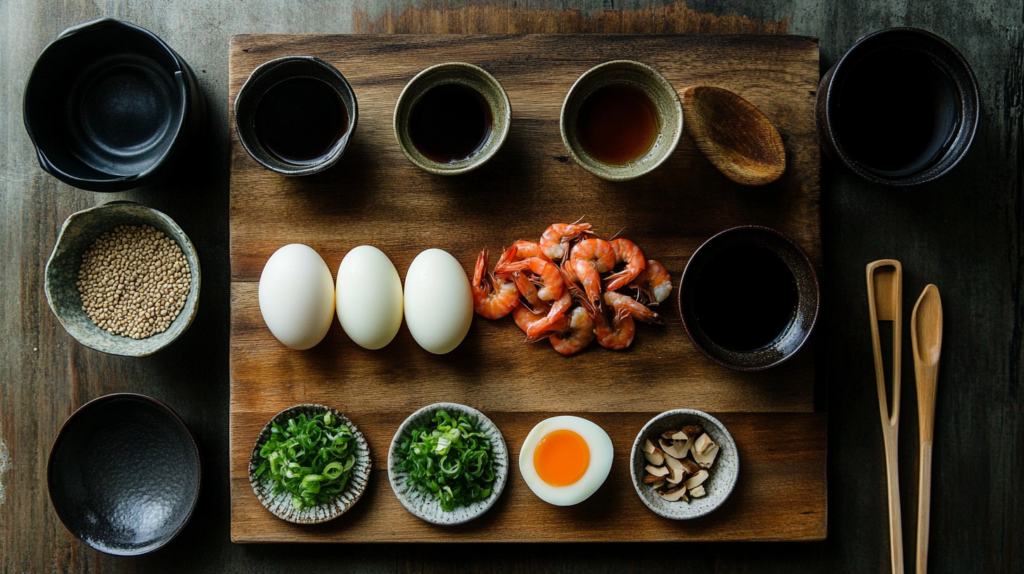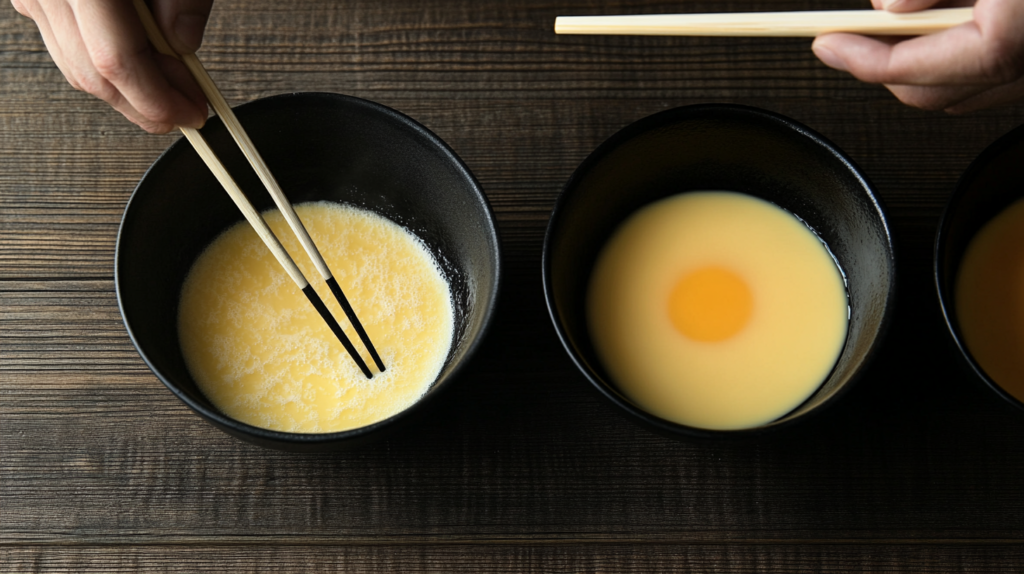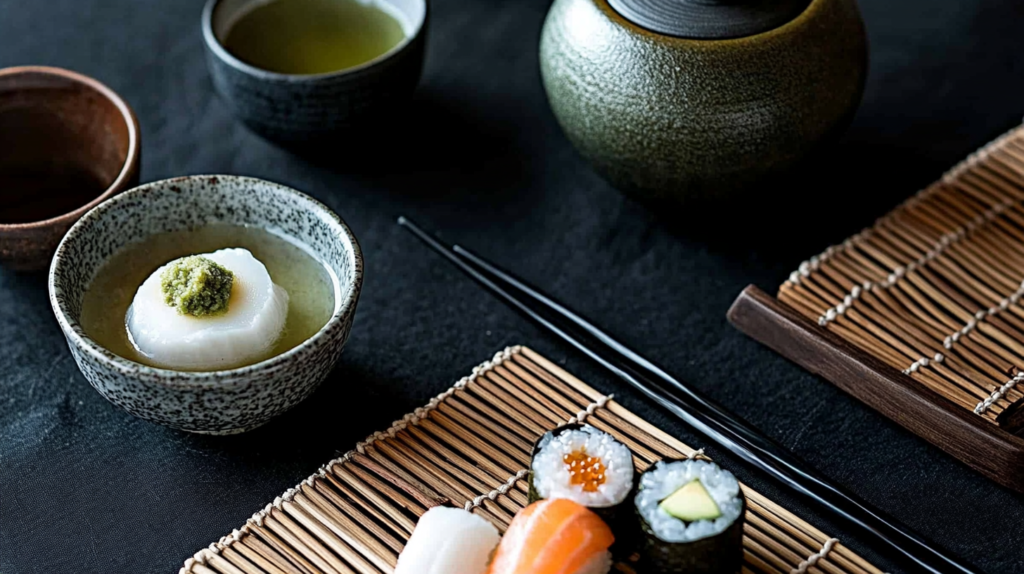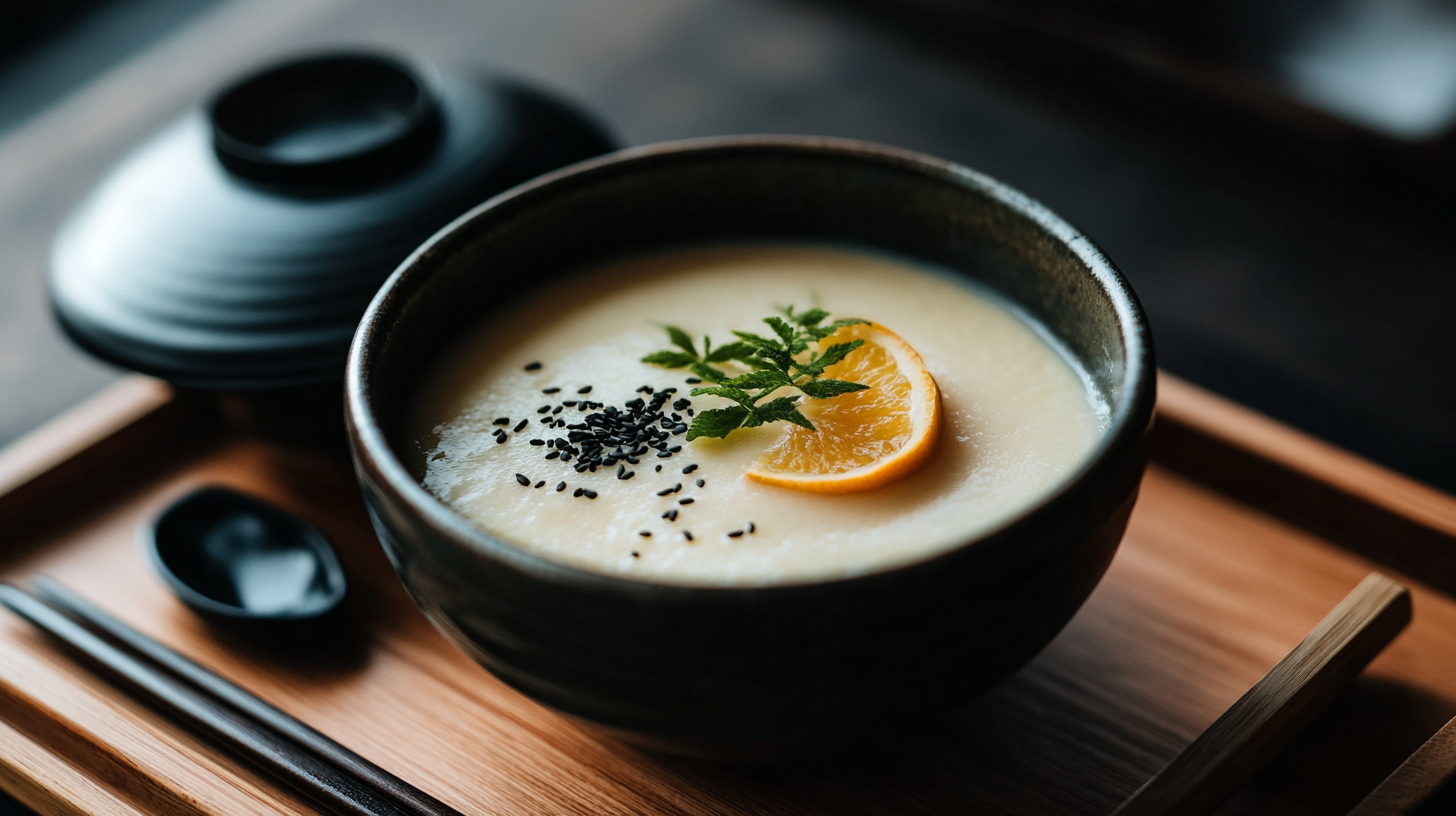Have you ever tried Chawanmushi? If not, you’re in for a treat! This silky, savory Japanese egg custard is like a warm hug in a cup. It’s delicate, packed with umami flavors, and surprisingly easy to make at home. Whether you’re a beginner in Japanese cuisine or an experienced foodie, mastering this dish will take your cooking skills to the next level.
“Chawanmushi is proof that simplicity can lead to pure elegance.”
Let’s dive into the wonderful world of Chawanmushi, where we’ll explore its origins, key ingredients, and how you can whip up your own at home. 🍳
Table of Contents
aWhat is Chawanmushi?
Chawanmushi (茶碗蒸し) literally translates to “steamed in a tea bowl.” It’s a traditional Japanese dish consisting of a smooth, savory egg custard flavored with dashi (Japanese soup stock) and filled with a variety of ingredients like mushrooms, shrimp, and ginkgo nuts.
Unlike sweet custards, chawanmushi is served as an appetizer or side dish in Japanese cuisine. It’s commonly found in restaurants, bento boxes, and even enjoyed during special occasions like New Year celebrations.
The History and Cultural Significance of Chawanmushi
Chawanmushi has been a part of Japanese cuisine for centuries. It’s believed to have originated from the Edo period (1603-1868) and has since become a staple in kaiseki (traditional multi-course meals). The dish showcases the essence of Japanese cooking: simplicity, balance, and harmony of flavors.
Why Chawanmushi is a Popular Dish
Why do people love chawanmushi so much? Because it’s:
- Light and comforting: The smooth, melt-in-your-mouth texture makes it perfect for all ages.
- Packed with umami: Thanks to dashi, soy sauce, and mirin.
- Customizable: You can add your favorite ingredients, from seafood to seasonal vegetables.
- Impressively elegant: It looks fancy, but it’s easier to make than you think!
Essential Ingredients for Authentic Chawanmushi

Making chawanmushi requires a few key ingredients that create its signature silky texture and rich umami taste. Here’s what you’ll need:
| Ingredient | Quantity | Purpose |
|---|---|---|
| Eggs | 2 large | Base for the custard |
| Dashi (Japanese soup stock) | 1 1/2 cups | Provides umami flavor |
| Soy Sauce | 1 tbsp | Seasoning |
| Mirin | 1 tbsp | Slight sweetness |
| Salt | 1/2 tsp | Enhances flavor |
| Chicken, shrimp, mushrooms | As desired | Adds texture and flavor |
| Ginkgo nuts (optional) | 4-6 pieces | Traditional addition |
Alternative Ingredients for a Modern Twist
If you’re feeling adventurous, you can experiment with modern variations:
- Vegetarian Chawanmushi: Replace dashi with vegetable broth and skip the meat.
- Seafood Delight: Add crab, scallops, or clams for an ocean-inspired version.
- Spicy Kick: A dash of chili oil or wasabi for an extra punch.
Where to Find Quality Ingredients
Wondering where to get these ingredients? You can find most of them in Japanese grocery stores or online. Look for authentic Japanese brands for the best taste. Don’t worry if you can’t find ginkgo nuts it’s totally optional!
Step-by-Step Chawanmushi Recipe Guide

Alright, it’s time to get cooking! Follow these steps, and you’ll have a perfect cup of chawanmushi in no time.
Preparing the Ingredients
Before you begin, gather all your ingredients and prep them properly:
- Eggs: Crack them into a bowl and whisk gently (don’t overbeat!).
- Dashi: Prepare fresh dashi or use instant dashi for convenience.
- Fillings: Cut chicken into bite-sized pieces, clean shrimp, and slice mushrooms.
Tip: For a smooth custard, strain the egg mixture through a sieve to remove air bubbles.
Making the Egg Mixture
In a bowl, mix the eggs with dashi, soy sauce, mirin, and salt. Stir gently to combine everything.
Keep the egg-to-dashi ratio at 1:3 (1 part egg to 3 parts dashi) for the perfect silky consistency.
Assembling the Chawanmushi
Divide the chicken, shrimp, and mushrooms evenly into small heatproof cups or ramekins. Slowly pour the egg mixture over the ingredients, filling the cups about 3/4 full.
Steaming Techniques
Now comes the magic part steaming. Follow these tips to ensure a smooth custard:
- Use a steamer or a pot with a lid.
- Steam on low heat for 15-20 minutes.
- Cover the cups with foil to prevent water from dripping onto the custard.
- Check for doneness by inserting a toothpick; it should come out clean but moist.
Common Mistakes to Avoid When Cooking Chawanmushi
To make sure your custard turns out silky smooth, avoid these common mistakes:
- Overcooking: Leads to a rubbery texture.
- High heat: Causes air bubbles to form.
- Skipping the sieve: Results in a grainy texture.
Follow these tips, and you’ll have a delicate, restaurant-quality chawanmushi right at home. 😍
Chawanmushi Variations You Should Try
One of the best things about chawanmushi is how versatile it is. Whether you prefer seafood, vegetarian options, or fusion flavors, there’s a version for everyone. Let’s explore some delicious variations you can try at home!
Seafood Chawanmushi
If you’re a seafood lover, this variation is perfect for you! Adding fresh seafood brings a delightful oceanic flavor to the custard. Here’s what you can add:
- Shrimp: Sweet and tender, shrimp pairs perfectly with the delicate custard.
- Scallops: Buttery and rich, scallops add a touch of elegance.
- Crab meat: Offers a slightly sweet, briny flavor that complements the umami broth.
Pro Tip: Lightly cook seafood before adding it to ensure it doesn’t release too much moisture into the custard.
Vegetarian Chawanmushi
Looking for a meat-free option? Vegetarian chawanmushi is just as delicious and packed with flavor. Here are some great ingredients to include:
- Shiitake mushrooms: They bring a rich, earthy taste and chewy texture.
- Edamame: These little green soybeans add a pop of color and protein.
- Tofu cubes: Soft, silky tofu blends beautifully with the egg custard.
Switch out the dashi for a vegetable broth to make this dish fully plant-based. 🌿
Fusion Chawanmushi
If you’re feeling adventurous, try adding unique twists to your chawanmushi! A few ideas include:
- Cheese: A sprinkle of parmesan or cheddar adds a creamy, rich texture.
- Truffle oil: A drizzle of truffle oil gives a luxurious aroma.
- Kimchi: Spicy fermented cabbage for a Korean-inspired twist.
“Experimenting with flavors is what makes cooking fun. Don’t be afraid to get creative with your chawanmushi!”
Common Problems and Solutions in Making Chawanmushi
Chawanmushi seems simple, but a few common mistakes can lead to less-than-perfect results. Let’s look at the most frequent issues and how to fix them.
Why is My Chawanmushi Too Watery?
A watery chawanmushi usually happens due to:
- Too much dashi: Stick to the 1:3 egg-to-dashi ratio for the perfect balance.
- Overcooking: Cooking at high heat can cause the egg to release excess water.
Solution: Steam on low heat and cover the cups with foil to trap moisture.
How to Prevent Overcooking and Achieve a Perfect Texture
If your chawanmushi comes out rubbery or grainy, it’s likely been overcooked. To prevent this:
- Keep the heat low and gentle.
- Cover the cups to avoid direct exposure to steam.
- Steam for about 15-20 minutes only.
Check by inserting a toothpick if it comes out clean but slightly wet, it’s done!
What to Do if Chawanmushi Turns Out Grainy?
A grainy texture can ruin the smooth experience of chawanmushi. This often happens because:
- The eggs were whisked too vigorously, incorporating too much air.
- The mixture wasn’t strained, leaving behind bits of egg.
Solution: Always strain the egg mixture and stir it gently instead of beating it.
Expert Tips for Perfect Chawanmushi Every Time
Want to make your chawanmushi restaurant-quality? Follow these expert tips to achieve the best results every time:
Tips on Ingredient Ratios for the Best Texture
- Stick to the 1:3 egg-to-dashi ratio. It ensures a light, delicate custard.
- Use fresh, high-quality dashi for a richer flavor.
- Add a pinch of sugar to balance the saltiness of soy sauce and dashi.
Steaming Techniques Used by Professional Chefs
Professional chefs have a few tricks up their sleeves when it comes to steaming chawanmushi:
- Use a bamboo steamer for even heat distribution.
- Let the egg mixture rest for 10 minutes before steaming to remove air bubbles.
- Place a cloth under the steamer lid to absorb excess moisture.
These little adjustments can make a big difference in texture! ✨
How to Serve Chawanmushi Like a Pro
Presentation matters! Here’s how you can impress your guests:
- Serve in traditional Japanese tea cups or small bowls.
- Garnish with a sprig of mitsuba (Japanese parsley) or a slice of yuzu peel.
- Pair with other Japanese dishes like sushi or miso soup for a complete meal.
With these tips, your chawanmushi will not only taste amazing but also look like it came straight from a Japanese restaurant! 🍵
Serving and Presentation Ideas for Chawanmushi

Now that you’ve mastered the art of making chawanmushi, let’s talk about how to serve it in style! Presentation can elevate this simple dish into an elegant appetizer or side dish.
Traditional Ways to Serve Chawanmushi
In Japan, chawanmushi is typically served in small, lidded cups called “chawan” (tea cups). Here’s how you can serve it the traditional way:
- Individual portions: Serve in ceramic cups with matching lids to retain warmth.
- Minimalist plating: A sprig of fresh mitsuba or a thin slice of yuzu peel adds a touch of color and aroma.
- Side dish pairing: Serve alongside sushi, sashimi, or miso soup for a balanced Japanese meal.
Creative Presentation Ideas for Special Occasions
If you’re hosting a dinner party or looking to impress guests, try these creative chawanmushi presentation ideas:
- Glass ramekins: Use transparent cups to showcase the beautiful layers inside.
- Bento box style: Serve chawanmushi in a bento box with other small Japanese delicacies.
- Garnish galore: Top with microgreens, edible flowers, or a drizzle of truffle oil for a gourmet touch.
“A beautifully served dish makes the dining experience even more delightful.”
Health Benefits of Chawanmushi
Aside from being delicious, chawanmushi is packed with nutritional benefits! Let’s break down what makes this dish a healthy addition to your diet.
Nutritional Value of Chawanmushi Ingredients
Here’s a quick look at the nutritional breakdown of a standard serving of chawanmushi:
| Nutrient | Amount per serving |
|---|---|
| Calories | 120 kcal |
| Protein | 9 g |
| Fat | 6 g |
| Carbohydrates | 4 g |
| Sodium | 500 mg |
The main health benefits of chawanmushi include:
- High in protein: Eggs and seafood provide a rich source of protein for muscle growth and repair.
- Low in carbs: Great for those following a low-carb or keto-friendly diet.
- Packed with vitamins: Dashi is loaded with minerals like calcium and magnesium.
- Gut-friendly: The light, smooth texture makes it easy to digest, perfect for people with sensitive stomachs.
Is Chawanmushi a Healthy Dish?
Absolutely! Since it’s steamed and doesn’t require oil, chawanmushi is a healthy choice compared to fried or heavily processed foods. Plus, it’s low in calories but still filling, making it an ideal light meal or snack.
Chawanmushi vs. Other Egg-Based Dishes
You might be wondering how does chawanmushi compare to other popular egg dishes? Let’s take a look:
| Dish | Key Differences |
|---|---|
| Chawanmushi | Savory, steamed, silky texture, Japanese flavors. |
| Chinese Steamed Egg | Simpler ingredients, usually just egg and water. |
| Western Egg Custard | Sweet, baked, often served as dessert. |
| Quiche | Baked, contains crust, and cheese-heavy. |
Each dish has its unique charm, but chawanmushi stands out for its delicate, umami-packed flavor profile.
Frequently Asked Questions (FAQs) About Chawanmushi
Let’s answer some of the most common questions about chawanmushi!
Can Chawanmushi Be Made in Advance?
Yes, you can prepare the custard mixture in advance and refrigerate it for up to 12 hours. When you’re ready to serve, just steam it fresh for the best texture.
How Long Can Chawanmushi Be Stored?
Chawanmushi can be stored in the fridge for up to 2 days. Reheat gently in a steamer or microwave to avoid overcooking.
What’s the Best Way to Reheat Chawanmushi?
To retain its silky texture, steam it for 5 minutes or use a low-power setting in the microwave, covered to avoid drying out.
Can I Freeze Chawanmushi?
Freezing is not recommended as it alters the custard’s texture, making it watery upon thawing.
Conclusion: Mastering the Art of Chawanmushi
By now, you’re well-equipped to create your own perfect bowl of chawanmushi. From choosing the right ingredients to mastering the steaming process, and even experimenting with creative variations this delicate Japanese dish is truly a joy to make and eat.
Whether you’re enjoying it as a comforting snack or serving it at an elegant dinner, chawanmushi always impresses with its delicate flavors and silky texture. So, why not give it a try today? You might just discover your new favorite dish! 🍵
Looking for a quick and easy recipe? Check out this fried rice instant pot recipe for a delicious side dish to complement your chawanmushi. 🍚
Happy cooking, and remember practice makes perfect!
People also ask:
What are the ingredients in chawanmushi?
Chawanmushi typically includes eggs, dashi (Japanese soup stock), soy sauce, mirin, salt, and fillings such as chicken, shrimp, mushrooms, and ginkgo nuts.
Is chawanmushi healthy?
Yes, chawanmushi is a healthy dish as it’s low in calories, high in protein, and packed with essential nutrients from eggs and dashi, making it a light and nutritious option.
Why is my chawanmushi not smooth?
Your chawanmushi may not be smooth due to overcooking, high steaming temperature, or not straining the egg mixture, which can create bubbles and a grainy texture.
How to make chawanmushi smooth?
To achieve a smooth chawanmushi, steam it gently at low heat, strain the egg mixture before pouring, and cover it with foil to prevent water droplets from affecting the texture.

Authentic Chawanmushi (Japanese Savory Egg Custard)
Equipment
- Steamer or Deep Saucepan: With a lid (a bamboo steamer works great, too)
- Heatproof Ramekins or Small Cups: 4 individual servings (about 4–6 oz each)
- Mixing Bowl: For combining the egg mixture
- Whisk or Chopsticks: To gently beat the eggs
- Fine Mesh Strainer: For ensuring an ultra-smooth custard
- Ladle: For portioning the mixture into cups
- Aluminum Foil or Lids: To cover the cups during steaming
Ingredients
- For the Egg Custard Mixture:
- 4 large eggs
- Use at room temperature for a smoother blend
- 2 cups dashi stock
- Preferably freshly made from kombu and bonito flakes, or a high-quality instant dashi
- ½ teaspoon salt
- 1 teaspoon soy sauce
- ½ teaspoon mirin
- Optional Add-Ins Arrange one or a combination in each cup:
- 4 small shrimp: Peeled deveined, and lightly scored
- ½ cup chicken thigh: Cooked and cut into bite-sized pieces
- 2 shiitake mushrooms: Stems removed caps sliced thinly
- A few slices of kamaboko fish cake
- A small handful of enoki mushrooms: Trimmed
- A few ginkgo nuts or other seasonal vegetables
- Tip: Feel free to substitute or add any ingredients you enjoy—traditional choices vary by region and season.
Instructions
- Prepare the Custard Mixture:
- In a large bowl, gently beat the eggs with a whisk or chopsticks. Avoid creating bubbles.
- Add the dashi, salt, soy sauce, and mirin. Stir very gently until fully incorporated.
- Strain the mixture through a fine mesh strainer into a clean bowl to remove any chalazae or unmixed egg, ensuring an ultra-smooth texture.
- Set Up the Cups:
- Lightly prepare your ramekins by placing your chosen add-ins (shrimp, chicken, mushrooms, etc.) evenly in the bottom of each cup.
- Slowly pour the strained egg mixture over the add-ins, filling each cup nearly to the rim (leave a little room for expansion).
- Cover and Steam:
- Cover each cup tightly with a piece of aluminum foil (or use a lid if your cups have one) to prevent water droplets from disrupting the custard’s smooth surface.
- Preheat your steamer or saucepan with about 1–2 inches of water. Ensure the water is at a gentle simmer; high heat can cause bubbles.
- Carefully place the cups in the steamer basket. Steam over low heat for approximately 15–20 minutes. (Cooking time may vary slightly depending on cup size and the strength of your heat source.)
- Check doneness by inserting a toothpick or a skewer into the center—it should come out clean, and the custard should be just set with a slight wobble in the middle.
- Finish and Serve:
- Once done, remove the cups from the steamer. Allow them to rest for a couple of minutes.
- Optionally, garnish with a few finely chopped mitsuba leaves or a sprinkle of chopped green onions.
- Serve warm as an elegant starter or a light main course.
- Details
- Prep Time: 15 minutes
- Cook Time: 15–20 minutes
- Total Time: Approximately 30–35 minutes
- Yield: 4 servings (one ramekin each)
- Category: Appetizer / Side Dish
- Method: Steaming
- Cuisine: Japanese
- Diet: Gluten-Free (provided that the soy sauce and dashi are gluten-free); low-carb and paleo-friendly with appropriate ingredient choices
- Keywords
- Japanese, Chawanmushi, Savory Egg Custard, Steamed Egg, Appetizer, Dashi, Traditional, Authentic, Gluten-Free, Healthy, Umami
- Nutrition (Approximate per Serving)
- Serving Size: 1 cup (approximately 150 g)
- Calories: ~130 kcal
- Sugar: ~1 g
- Sodium: ~250 mg
- Total Fat: ~6 g
- Saturated Fat: ~2 g
- Unsaturated Fat: ~4 g
- Trans Fat: 0 g
- Carbohydrates: ~8 g
- Fiber: ~1 g
- Protein: ~10 g
- Cholesterol: ~160 mg
- Note: Nutritional values can vary based on the specific ingredients and add-ins used.
Notes
Straining is Key: Straining the egg mixture ensures a silky texture, free from chalazae or clumps.
Steaming Temperature: Use low heat during steaming to prevent rapid boiling, which can cause uneven setting or bubbly texture.
Customizable: Experiment with different add-ins—seasonal vegetables, seafood, or even tofu—for a personal touch.
Timing: Adjust the steaming time if using larger or deeper cups; always check for a clean toothpick test in the center.
Dashi Quality: High-quality dashi significantly enhances the flavor profile, so opt for homemade if possible.
Enjoy preparing and savoring this classic Japanese dish that marries simplicity with depth of flavor!
